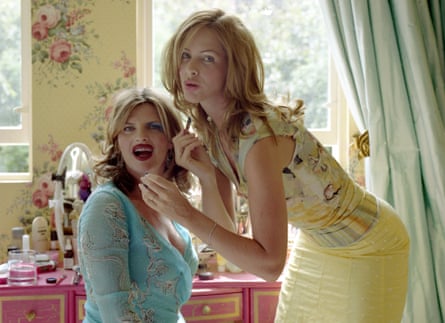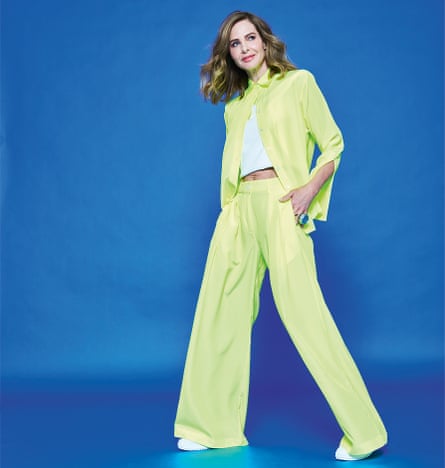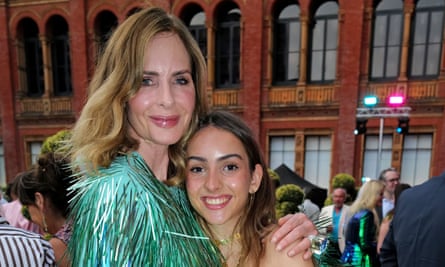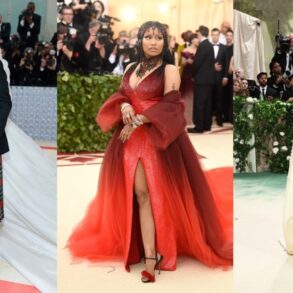Trinny Woodall is wearing all white – white suit, white waistcoat, white mesh platforms – and not just any old white, but white-white, as she calls it in her Instagram chats, the brightest, bleachiest white on the spectrum. She is scoffing a flaky croissant, which arrived with a square of soft yellow butter and a huge dollop of red-red jam. (“Thank you, Jonathan,” to the assistant; to me, “You sure you won’t have a bit?”) I watch as she alternates croissant and sloping bowl of coffee to her lips, unfazed by the danger to her suit. She’s talking in galloping vowels about a crash she had days earlier, a three-car collision on the corner of the street where she stayed in LA. Bruising makes it hard to sit for too long. She shifts her bottom, then heaves herself to stand and now is stamping round the cafe like a stabled thoroughbred. “My body is out of sync,” she says, “my knee and my ankle. I am bruised everywhere.”
On her left wrist is a white wound dressing of the hospital sort, but she flaps off my concern. There’s a lot of old school don’t-make-a-fuss about Woodall, who is 59. She says “darling” a lot, and “fuck”. Of the accident, I am imagining concertina-bonnets and wailing sirens; Woodall emerging through engine smoke in something from Zara, a neon suit, perhaps, or Alaïa (high street or high end: mid-range is “a waste of money”), keen to keep to the schedule because this trip to LA was after all mostly business. Beside her daughter Lyla, 19, work is Woodall’s primary and unrelenting preoccupation.
Many will remember Woodall as one part of the 00s TV makeover duo Trinny and Susannah, and an early online fashion influencer. Though fashion is still integral to what she does, work is her cosmetic company, Trinny London, the makeup range she launched in 2017, which expanded to skincare in April 2022. In building this business she sold her house and £60,000 worth of clothes, and after white-knuckling an initial wobble, the brand rallied. Talk of her “stacking pots” – her products slot into each other to make them portable – seemed suddenly everywhere. Growth exploded during the pandemic. The company has 222 employees and sells in the UK, Australia and the US. A bottle of her BFF Skin Perfector, costing £39, sells every 30 seconds (every 15 when it launched).
Of course, products are only part of the Trinny experience. Woodall posts to her 4 million plus social media followers multiple times a day. She might log on yawning, makeup-free, swearing or saying she looks like “cat sick”. She races through her routine, squawking when, say, her sheet mask falls off, reporting on bodily functions, telling whoever is knocking furiously at the bathroom door, “Just a minute, I’m in the middle of something.” In one post she uses a dog nappy to dye her eyelashes; in another she has a bikini wax while assistants wrap presents. Viewers join her pilates sessions. She films her “outfit of the day” and Closet Confessions, as well as a bizarre segment called Friday Twinning in which she and a different-sized friend try on identical clothes. Makeup tutorials are haphazard. “I slap it on,” she says. “I don’t always have my glasses, so it’s not always perfect. But I’m saying to people: ‘It doesn’t matter. Just try something new.’” Her presentation style is so off-the-wall that Irish comedian Ruairi McInerney has turned her into a sketch, looming into view with a bad wig, hectic blusher and the catchphrase, “Hello ladieeeees!”
In the bleakest days of lockdown Woodall provided a refuge, drawing legions of women – Trinny Tribes, she calls them – who found respite in her clattering, frank disclosures, such as when her hair began to fall out. “They might’ve had a full household, but so many women at home felt lonely,” she says. “I felt lonely.” At the time she was living with the art dealer Charles Saatchi. In one live stream, in which Woodall was chatting through a glowing LED mask, his rotund naked form was seen disappearing into the shower.
In March, Woodall told her followers she had moved house to begin “a new life”. There was barely a blip in her output, although she referred obliquely to “a shitty week”. Now she rents in Notting Hill, she tells me. There were rumours Saatchi suddenly stopped speaking to her before she left, but Woodall parses the breakup like this: “Things sometimes come to a natural end.” I ask how Lyla feels. “It hasn’t affected her in any negative way.” Will she and Saatchi be friends? “I’d say that we’re both people who live in the present and the future.” After a pause she adds a crisp, “Yup.”
Woodall was introduced to Saatchi at a dinner party and afterwards he asked her for lunch, saying he’d heard she was good at Scrabble, did she fancy a game? Does she understand bemusement at how she could have dated Saatchi after he was photographed in Mayfair in June 2013, his hand around then-wife Nigella Lawson’s neck? “When I met Charles,” she says, “I’d been abroad filming for nine months. I hadn’t seen the photograph; I didn’t know. Maybe nobody knows [what happened in] the exact moment or what was said at that table. But I didn’t have any pre-judgment when we met. I met somebody who I found fascinating, who was super fucking smart, and who challenged me as a person: on my opinions, on my intelligence. Those things were very appealing. Because I am quite a strong character.”
She has “never gone out in my life with pretty boys,” she says. “I had a mixture of wacky men.” Lyla’s father Johnny Elichaoff – whom she married in 1999 and divorced in 2009 – had “a phenomenal sense of humour. He wasn’t incredibly handsome, but he was super smart and somewhat flawed.” Of Saatchi, she says, “I wouldn’t have been in the relationship for 10 years if I didn’t find a number of those years very happy, where I was with somebody who taught me a lot, who fiercely cared about me. There are things we see, and we don’t know what’s under the bonnet. I’d say that about many different things.”
People have misjudged her a lot, she believes (she is irritated by those who wrongly put her company’s success down to Saatchi’s money). It bothered her greatly when she was young and “less resourceful”, but today she has enough confidence to know who she is, and it “doesn’t worry me any more”. She has launched a podcast series entitled Fearless and next month releases a book with the same title. Those hoping for a tell-all on addiction, grief or her breakup with Saatchi might be disappointed. It’s a manual, she stresses. “I wouldn’t do an autobiography. I find them creepy.” She shudders, then adds: “No, creepy is the wrong word. I’d just feel odd, uncomfortable.”
Woodall is actually Sarah-Jane, but was dubbed Trinny after a family friend likened her to a character from the St Trinian’s films he directed. Her first love was always clothes, and her Ready to Wear column in the Daily Telegraph with Susannah Constantine was what brought her bursting into the public consciousness. Both were consummate 90s Notting Hillers, Woodall bombing about in a pink Mini, as frenetic in traffic as tearing through a wardrobe. “Clothes over diet!” was an early refrain. I remember seeing her in a cyclone of trying-on in a shop in Holland Park. “Topless?” she suggests when I mention it. Yes. She admits she had no problem trying things on where she was standing, even if it meant stripping to her knickers on the shop floor.

The column morphed into the BBC What Not to Wear makeover series, launched in 2001, with more than 7 million viewers at its peak. Audiences couldn’t get enough of these two clomping toffs with little respect for personal space. Woodall doesn’t like to be reminded that they measured the cup size of hapless women with their hands. She is horrified, too, that the programme put secret cameras in the bedrooms of women whose husbands thought they needed makeovers. “That was telly in the 2000s. It’s like, really?” But after a beat she adds that whenever they put somebody in front of a mirror, “Susannah and I stripped down with them. We would never make them go on a journey by themselves.”
When they were “no longer flavour of the month” in the UK, they presented a global spin-off. God knows what Norway, Peru and the UAE, among others, made of them. On reflection, Woodall believes that format inspired the business she has today. “It was a far more emotive show,” she says, and she frequently went off-script. One segment saw her “making over” a 6ft 7in Israeli former basketball player who had “lost it” after military service. His girlfriend had taken off and he smoked joints all day. “He was so dopey I said, ‘You’re coming to my hotel.’ I put him in the bath and – this was before ice baths– put all this ice on him. The production company was saying: ‘Trinny, I don’t know how long you should leave him in the bath.’ I said: ‘Put your head under the water now’ because I needed him to wake up. He was like: ‘I can’t.’ I said: ‘You stay under another two minutes.’ Then he fucking woke up. I saw his brain. He could talk. At the end of the day, I took him to an NA [Narcotics Anonymous] meeting in a bomb shelter. I had the freedom to really try to have an impact on somebody and it was so powerful. I loved doing that. I feel that couldn’t be done today.”
When I ask if she took anyone else to NA, she becomes hesitant, the gush of words halting. Woodall went into rehab for cocaine addiction twice: first after an overdose aged 21, which her parents paid for by selling a table at Sotheby’s; second, aged 26, which she paid for herself by selling jewellery. She stayed for months including a stint in a halfway house, and for seven years thereafter went to NA meetings every day. Those meetings were her solace, although she’s not generally prescriptive on how others should handle their own recovery. The roots of addiction are nebulous; she can’t say for sure what fuelled hers, although she had a terrible lack of confidence (and chronic acne, for which she was treated with three rounds of hardcore medication). “There’s evidence for alcoholism being hereditary, but alcohol was never my problem. So. All I know is that I’d never touch a drug again. Whether it’s because I went to meetings every day for seven years …” She shrugs. “When you don’t experience something well, you don’t want to go back. That’s what it boils down to.”
Beyond NA, it was the idea of rebuilding people’s confidence that kept her going. Her Tribes, for instance, are mostly post-40, an age when women often feel lost or invisible. There is something of the fellowship model in the turn-up-and-gather-round nature of her live videos: “It’s a supportive community that doesn’t judge. It’s a nice thing to foster that sensibility in people.” I mention this is also a time women feel attacked by society and are considered fair game for slurs such as witch or Karen. Woodall asks her assistant Molly to give her a definition of Karen. “People who complain a lot,” she says. Woodall responds: “Well, I can complain if I don’t like something. And I’m a bit of a witch because I have this intuition sometimes. So I should think I’m a witch and a Karen.”
We have met very early in a canal-side cafe in north London, shadows still moving on the water before the sun takes full possession of the day. Woodall doesn’t seem jet-lagged, but she tacked two days’ holiday on the end of her trip, she says. She wants to tell me a story about how she and Lyla drove out to a country fair in Topanga, California (“full of hippies”) and how, as they parked in a field, a lady, 40ish, whom she’d never met, leaned in to her open window and said, “‘Hi Trinny, how are you? Hey, I loved Closet Confessions this week. I have on Schmoogie.’” Woodall does an impression of this woman pouting and pressing her forefinger against her lips as if to apply colour. “Honestly, it was the best moment,” she says. “This woman in Topanga, in the middle of a canyon outside LA, knew about Trinny London. How? That’s the most exciting thing. That’s what I want.”
By contrast, the toughest moments were fundraising from venture capitalists. Many were young men in their 30s who made her feel crazy proposing a brand for 35-plus women. “I was in this horseshoe room, seven men like this.” She slides down her chair to adopt the position of your average bored male vice-chair: arms crossed behind head, ankle slung over knee. The only other woman present was the only person leaning forward, she says. “At the end, the person who’d come with me said: ‘They’re not going to invest.’ I said: why? ‘Body language.’” They were right: the men turned her down: “But the woman VC called after and said, ‘Can I invest personally?’” Woodall makes a noise like ffffff.
She was 50 when she sought funding in 2014 and was surprised to find people judged her for it. “Ageism is interesting because I’ve never defined myself by my age. I feel ageless. I talk a lot to people about how they feel ageless. Then I had, ‘How long do you think you’ll be able to work with the company?’ Like fuck, I’m 50. What do you think that is, 70? Because I don’t feel old.” The compounding irony was that 50 was the age she stopped worrying what people thought of her. “I didn’t stop caring, I stopped worrying. I get that little fizz now when I have to, say, give a talk with 3,000 women, which is healthy. It’s not nervousness. I feel there’s so much to do; I have this finite amount of time. Right?”




Her energy and approach is hurtling. Many products came about as a result of Woodall standing in her bathroom experimenting with concoctions for things she wished existed. She created De-Stress, the company’s second biggest seller, with a key ingredient that, “this is a very unscientific way of explaining, but it reduces the level of cortisol in your skin”. Unable to test widely because of Covid restrictions, she was her own guinea pig. One morning she looked in the mirror and thought, “God, I look like shit” and slapped on the prototype. Hours later a friend came to the door and said, “Trinny! Trinny! You look amazing!”
“I said: ‘Suzanna, I look like shit.’”
But her friend was so effusive, Woodall went up to the mirror, “horrified by the idea of her being such a liar. I really looked great. I was like, ‘Fuck! We have it!’”
after newsletter promotion
Her “lab” is working on 14 other ideas, including one for the neck. Woodall plucks her own. “We have tons of muscles on our face and tons of opportunities for tightening up slackness. But when you get menopausal, your epidermis and dermis separate in the neck. I’m thinking: ‘What ingredient can literally glue those two back together?’ A crazy idea, all right. At the moment you can spend £200 on Le Mer or Sisley or whatever, but is it going to change your neck? I’m thinking: ‘Could I be the person to invent something that works?’”
I mention that Charlotte Tilbury sold her eponymous company for £1bn in 2020 and ask if she sees anything like that on the horizon for Trinny London. “I remember reading that and thinking, wow,” Woodall says. “She got an incredible valuation at a very good time in the market. And she’s clever. She’s unbelievable. She’s fantastic. Charlotte is”– she sighs as if to say, how do I put this?– “we are both very driven. In slightly different ways. It’s not like I’m already on to my next thing because my life is Trinny London. But if it does well and we do something with it in a few years, I have an idea of what I’d like to do with that money. I will help other women starting businesses, globally; female founders in early stage. Because it’s very, very difficult.”
Woodall’s entrepreneurial spirit stretches back to her teens. She started Bow Unlimited while at school, flogging Diana, Princess of Wales-style velvet hair ties decorated with brooches to places such as Harvey Nichols. Her second effort, Sock It To You, had pretty Sloanes wielding baskets of socks round trading floors in the City. She was besieged by complaints when the colour ran and the elastic gave.
Her fashion flair she attributes to her banker father, Bruce, a bit of a dandy in a Harvie & Hudson covert coat and Turnbull & Asser pyjamas. Trinny filched these to wear clubbing but, with terrible fake tan to conceal her acne, “Everyone just remembers me being orange.”
Bruce was married twice, and Woodall was the last of his six children. She had a complicated relationship with her mother, Ann, and her parents moved abroad when she was six. She was dispatched to a prep school, where she found she could make friends by tweaking other girls’ uniforms and offering fashion and makeup tips. Perhaps the most explicit example of how hands-off her parents were is no one told her about menstruation. She was horrified when she got her period. “I called my sister and said: ‘I’ve got blood coming out of my bottom.’ This was not the 1950s,” she adds, “this was the 1970s. But nobody had told me for whatever reason.”




Her parenting of Lyla is “fundamentally different. It wasn’t that I didn’t love my parents, I did. But the intimacy I have with Lyla I’m grateful for. You have to learn [how to do it differently] because you didn’t experience it. It’s a new process.” Woodall and Elichaoff went through 16 rounds of IVF – nine before Lyla was conceived – and she suffered multiple miscarriages, including one at 18 weeks when she had to give birth. It was at the peak of her TV career and on she soldiered.
Meanwhile Elichaoff, a musician and businessman, had his own battles, not least a two-decade addiction to painkillers after a motorbike accident. They remained close after divorce, speaking “sometimes twice a day”, and spending holidays with his older son, Zak, and Zak’s mother, Milly. “We were very blended.”
It’s impossible to convey the devastation she felt in November 2014 when she opened the front door to two police officers, who had come to inform her of Elichaoff’s death by suicide. Woodall’s first thought was how she was going to break the news to Lyla. She contacted the grief counsellor Julia Samuel, who gave the exact words to tell her daughter when she returned from school.
In an interview with You magazine in 2017, she described how Lyla knew something was going on because of the number of people in their house. “We sat on the bed and I gave her a hug and said: ‘Dada’s died.’ I just held her, and Zak came and held her … and together, somehow we got through.”
How? “It’s survival. ‘Life goes on’ sounds so trite, but life does not stand still. So we shouldn’t stand still. If you stand still, you go backwards.” After her father’s death she compulsively tidied her house, moving furniture that she wouldn’t otherwise have had the strength to lift. “In grief, you go into autopilot, you mechanically go through the motions. If you keep going through the motions, then the engine will start again. If you don’t, it might not. You’ve got to get into habits, one day goes to the next and then it gets a bit easier. If you do what-ifs it’ll kill you.”
She kept a document of all the messages she was sent after Elichaoff’s death, which ran to 500 pages. She has printed it off and put it in a box in case Lyla ever wants to see them. “I don’t even know yet if it’s the right thing to show her. It could be too raw. I just need to have it there in case.” She gets up from the sofa we’re sharing and goes to stand with her back to the wall. “The moments I feel most upset are when I see other dads and daughters.” At a teenage party recently she saw girls dancing with their dads. “I get upset even thinking about it.” She pauses. “Those things. Those things.” She stops to recover herself. Then says, “It’s much easier to allow yourself to feel [by] having responsibility for how somebody else feels, [by] thinking she might think this and allowing yourself to be upset.” In truth, Lyla “may be happy she can dance with me. I’m a cool, fun mum. Perhaps.”
She says she made the mistake of calling Lyla straight after the crash in LA. “I said, ‘Darling, I’ve been in an accident.’ She went from one to 3,000 because that’s the worst thing she could hear. Even though I was physically speaking to her and fine, it was the words, ‘I’ve been in an accident.’ I thought, fuck, I shouldn’t have said that. I said: ‘Darling, I’m at the end of the road, I’m fine.’ But she ran up the road. I felt really weird afterwards. You’re very aware of that thing: you only have each other.”
Does she care whether she finds another relationship after the break with Saatchi? “Interesting one.” She pauses to think. “I’m at an age where classically, it’s more challenging for people to have relationships. And I so do not wish it, I have so much going on in my life. The most important thing is to get Lyla feeling really good about herself: comfortable and confident. Then to get Trinny London into a really good place for whatever journey I want to take it on.
“I am fortunate. I’m 59 in a place where a lot of people might be at 30. So where there would be room for somebody … They’d have to fit into the life I have and that’s a challenge for some people.” Also, a relationship “won’t complete me. I feel completed. I have a wonderful daughter I’m very proud of, a business that is going places and exciting, great friends and family. So that’s like 95% of the pie.”
This post was originally published on this site be sure to check out more of their content.






